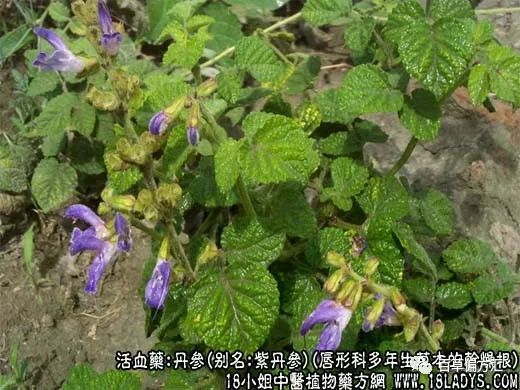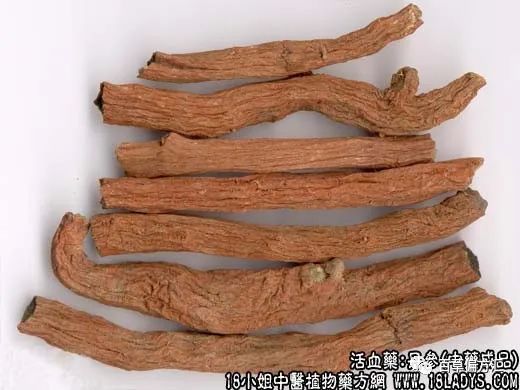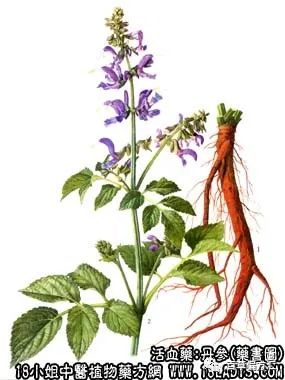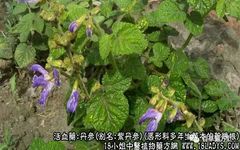


This herb is a commonly used traditional Chinese medicine (TCM). It was first recorded in the Shen Nong Ben Cao Jing (Shen Nong’s Classic of Materia Medica) and classified as a superior herb. In the Ming Yi Bie Lu, it is also known as “Chi Shen” (Red Root) due to its red color.
Alias: Zi Dan Shen (Purple Dan Shen).
Source: The dried root of the perennial herb Salvia miltiorrhiza Bunge, belonging to the Lamiaceae family. It can be found in the wild or cultivated.
Plant morphology: A perennial herb, 30-80 cm tall, covered with fine yellowish hairs. The stem is upright and square, with many branches at the top. The leaves are opposite, odd-pinnate, with 3-5 leaflets; the terminal leaflet is the largest, oval or ovate with blunt serrated edges. The flowers are arranged in racemes, tubular, and pale purple. The small achenes are elongated, dark brown or black when ripe. The root is bright red.
Production area: Mainly produced in Hebei, Anhui, Jiangsu, Sichuan, and distributed throughout the country.
Identification: The wild root is rough, with stem scars at the top and several cylindrical lateral roots below. It is 10-20 cm long and 3-10 mm in diameter, with a reddish-brown or brick-red underside. It has irregular longitudinal wrinkles, and the cork layer is easily peeled off. It is light and brittle, easily broken, with a yellowish-white fracture surface that is loose and shows fibrous structure. The aroma is faint, and the taste is slightly sweet and bitter. The best quality is characterized by thick roots, purple-red color, and no fibrous head.
Main components: Contains Danshenone A (C18H12O2), Danshenone B (C19H18O2), Danshenone C (C19H20O2), and Dihydrodanshenone (C19H20O3), as well as Vitamin E.
Efficacy and functions: Invigorates blood circulation and removes blood stasis, clears heat and alleviates irritability. Its known effects include: 1. Vasodilation and blood pressure reduction; animal experiments preliminarily indicate that Dan Shen can dilate peripheral blood vessels and lower blood pressure. 2. Antibacterial properties; it has strong inhibitory effects on Staphylococcus, Escherichia coli, and Proteus; it also shows some inhibitory effects on typhoid and dysentery bacteria. Its alcohol extract can inhibit tuberculosis bacteria even at a concentration of 1:100,000, and animal tests show efficacy against experimental tuberculosis in mice. Clinical observations also indicate sedative, calming, and analgesic effects.
Note: Recent animal experiments have preliminarily found that Dan Shen significantly prolongs the survival of mice with ascitic cancer, suggesting potential anti-cancer effects, but its anti-cancer value has not yet been confirmed clinically. Although Dan Shen is used in some cancer treatment formulas, it is not considered a primary herb.
Preparation: Sliced, used raw.
Taste and properties: Bitter, slightly cold.
Meridians: Heart and Liver meridians.
Functions: Invigorates blood circulation, cools blood, reduces swelling, alleviates irritability, and clears the heart.
Indications: Dysmenorrhea, amenorrhea, abdominal masses, pain due to blood stasis, carbuncles, and irritability.
Clinical applications: 1. Used to treat angina pectoris caused by coronary artery obstruction, leveraging its ability to unblock stasis and dilate blood vessels. For mild cases, it can be combined with sandalwood and cardamom, as in Dan Shen Decoction. It can also be combined with Puhuang (Typhae Pollen), Wulingzhi (Flying Squirrel), and Yujin (Curcuma) for oral administration. For blood stasis with yin deficiency, it can be combined with Shengmai San (Sheng Mai Powder) as Dan Shen Sheng Mai San with modifications. Reports indicate that Dan Shen injection has shown good effects in emergency treatment of myocardial infarction, with rapid improvement in ECG ischemia in some patients and a decrease in blood lipids.
2. Used to treat menstrual difficulties and dysmenorrhea caused by qi stagnation and blood stasis, and postpartum lochia retention. It can be taken alone as a powder (Dan Shen San), 6g per dose, taken with aged wine or warm water, or combined with Tao Ren (Peach Kernel), Gui Wei (Rehmannia), and Hong Hua (Carthamus) for decoction.
3. Used to treat neurasthenia due to insufficient heart blood, with symptoms of palpitations, insomnia, and irritability. It can be used with 12g of Dan Shen, decocted with Zishi (Amethyst), Long Gu (Dragon Bone), Mu Li (Oyster Shell), and Shudao Ren (Jujube Seed) for oral administration. It can also be used in the form of a patent medicine called Bu Xin Dan (Heart-Supplementing Pill) containing Dang Shen (Codonopsis), Dan Shen, Xuan Shen (Scrophularia), Zhu Sha (Cinnabar), Wu Wei Zi (Schisandra), Suan Zao Ren (Sour Jujube Seed), Bai Zi Ren (Platycladus), Yuan Zhi (Polygala), and Dang Gui (Angelica).
4. Used to treat liver qi stagnation and hypochondriac pain, suitable for chronic hepatitis and early cirrhosis with liver and spleen enlargement and poor liver function, leveraging its ability to remove stasis. Commonly used with 30g of Dan Shen, 30g of glutinous rice root, and 30g of brown sugar, boiled in 5 bowls of water to 2 bowls, taken warm in 2-3 doses, which seems to help lower ALT levels. Although some use Dan Shen for acute infectious hepatitis, it is more suitable for chronic liver disease.
5. Used to treat thromboangiitis obliterans, suitable for milder cases, often combined with Dang Gui, Yuan Shen, and Ji Xue Teng (Spatholobus) as in Dan Shen Tong Mai Decoction.
6. Used to treat hypertension, leveraging its hypotensive and sedative effects, often combined with Ji Xue Teng and Shi (Magnetite).
Usage precautions: 1. Ancients believed that Dan Shen could both remove blood stasis and nourish blood, thus it was praised as “one herb of Dan Shen, equal to four substances”. This evaluation is somewhat exaggerated; in reality, while Dan Shen and Si Wu Tang (Four Substance Decoction) both invigorate blood and remove stasis, Si Wu Tang also has blood-nourishing properties, which Dan Shen lacks.
2. This herb has a mild nature, but in rare cases, it may prolong bleeding time and coagulation time. Patients with bleeding disorders should use Dan Shen with caution.
3. This herb is traditionally contraindicated with Li Lu (Veratrum).
Dosage: For invigorating blood and removing stasis, generally use 6-15g, with larger doses of 15-30g. For treating vasculitis, higher doses of 30-60g may be used, but large doses are not recommended for those with bleeding tendencies.
Example prescriptions: 1. Dan Shen Decoction (from Yi Zong Jin Jian): Dan Shen 30g, sandalwood 3g, cardamom 3g, decocted in water.
2. Modified Dan Shen Sheng Mai San: Dan Shen 15g, Dang Shen 19g, Mai Dong (Ophiopogon) 18g, Wu Wei Zi 6g, Shan Yu Rou (Cornus) 12g, glutinous rice root 24g, Sheng Di Huang (Rehmannia) 18g, decocted in water.
3. Dan Shen Tong Mai Decoction: Dan Shen 30g, Ji Xue Teng 30g, Dang Gui 18g, Yuan Shen 30g, Gan Cao (Licorice) 30g, decocted in water.
Note: The majority of Dan Shen used in most regions of the country is the wild variety described above, consistent with historical materia medica records. However, cultivated Dan Shen often varies in characteristics due to differences in climate and soil; furthermore, roots from different species within the same family can differ significantly, leading to different commercial names. The following are discussed:
1. Chuan Dan Shen (cultivated in Sichuan and Zhongjiang): The original plant is the same as Dan Shen. Its characteristics include a prominent main root with few branches, generally larger and thicker than the wild variety, with a diameter of 5-15 mm. The skin is reddish-brown, oily, and has fine longitudinal wrinkles, with a cork layer that is not easily peeled off, and a solid texture. The fracture surface is yellow-brown, fleshy, and has few fibers. The aroma is weak, and the taste is slightly sweet.
2. Gansu Dan Shen: The dried root of the plants Ganshi Shuren and Heimao Dan Shen. The roots are conical, often twisted into rope-like shapes, 15-25 cm long or longer, with a diameter of 1-6 cm. The top shows parallel cylindrical stem scars, and the surface is reddish-brown with twisted longitudinal grooves. The texture is loose and easily broken, with a loose fracture surface, the exterior is reddish-brown, and the wood core is yellow-white, dotted and scattered between the skin. The aroma is faint, and the taste is slightly astringent. This type of Dan Shen was originally used in Gansu, Ningxia, and Qinghai, and has recently been used in Beijing and Tianjin. Due to its shape resembling the medicinal herb Qin Jiao, it has been mistakenly used in some regions, which should be corrected. Additionally, there are varieties such as Dian Dan Shen (Yunnan), San Ye Dan Shen (Three-leaf Dan Shen), Bai Bei Dan Shen (White-backed Dan Shen), and Xiao Dan Shen (Small Dan Shen), all of which are locally produced.
3. This herb is contraindicated with Li Lu.
More Exciting Recommendations:
Chinese Herbs: The Efficacy of Zi Su
Chinese Herbs: The Efficacy of Yin Chen
Chinese Herbs: The Efficacy and Functions of Ban Xia
Chinese Herbs: The Efficacy and Functions of Chui Pen Cao (6 Major Effects and Usage Methods)
The above contentis sourced from the internet,for reference only,please delete if infringing!
Follow your physician’s advice! Do not self-medicate! Be the first to collect and share with friends,the more people see it, the more health benefits!
Be the first to collect and share with friends,the more people see it, the more health benefits!

